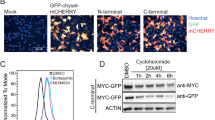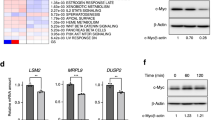Abstract
c-Myc is a proto-oncoprotein that regulates various cellular processes and whose abnormal expression leads to tumorigenesis. c-Myc protein stability has been shown to be predominantly controlled by the ubiquitin ligase (E3) CRL1Fbxw7 in a manner dependent on glycogen synthase kinase 3 (GSK3)–mediated phosphorylation. Here we show that, in some types of cancer cells, c-Myc degradation is largely insensitive to the GSK3 inhibitor (GSK3i) CHIR99021, suggesting the existence of an E3 other than CRL1Fbxw7 for c-Myc degradation. Mass spectrometry identified CRL2KLHDC3 as such an E3. In GSK3i-insensitive cancer cells, combined depletion of Fbxw7 and KLHDC3 resulted in marked stabilization of c-Myc, suggestive of a cooperative action of Fbxw7 and KLHDC3. Furthermore, transplantation of such cells deficient in both Fbxw7 and KLHDC3 into immunodeficient mice gave rise to larger tumors compared with those formed by cells lacking only Fbxw7. GSK3i-insensitive pancreatic cancer cells expressed lower levels of SHISA2, a negative regulator of the Wnt signaling pathway, than did GSK3i-sensitive cells. KLHDC3 mRNA abundance was associated with prognosis in pancreatic cancer patients with a low level of SHISA2 gene expression. These results suggest that KLHDC3 cooperates with Fbxw7 to promote c-Myc degradation in a subset of cancer cells with low GSK3 activity.
This is a preview of subscription content, access via your institution
Access options
Subscribe to this journal
Receive 50 print issues and online access
$259.00 per year
only $5.18 per issue
Buy this article
- Purchase on Springer Link
- Instant access to full article PDF
Prices may be subject to local taxes which are calculated during checkout








Similar content being viewed by others
Data availability
All proteome data are available in ProteomeXchange and jPOSTrepo under the accession numbers PXD047181 and JPST002393, respectively.
References
Li Z, Van Calcar S, Qu C, Cavenee WK, Zhang MQ, Ren B. A global transcriptional regulatory role for c-Myc in Burkitt’s lymphoma cells. Proc Natl Acad Sci USA. 2003;100:8164–9.
Dang CV. MYC on the path to cancer. Cell. 2012;149:22–35.
Vita M, Henriksson M. The Myc oncoprotein as a therapeutic target for human cancer. Semin Cancer Biol 2006;16:318–30.
Tansey WP. Mammalian MYC Proteins and Cancer. N J Sci 2014;2014:1–27.
Schaub FX, Dhankani V, Berger AC, Trivedi M, Richardson AB, Shaw R, et al. Pan-cancer Alterations of the MYC Oncogene and Its Proximal Network across the Cancer Genome Atlas. Cell Syst. 2018;6:282–300.e282.
Baudino TA, McKay C, Pendeville-Samain H, Nilsson JA, Maclean KH, White EL, et al. c-Myc is essential for vasculogenesis and angiogenesis during development and tumor progression. Genes Dev. 2002;16:2530–43.
Davis AC, Wims M, Spotts GD, Hann SR, Bradley A. A null c-myc mutation causes lethality before 10.5 days of gestation in homozygotes and reduced fertility in heterozygous female mice. Genes Dev. 1993;7:671–82.
Bazarov AV, Adachi S, Li SF, Mateyak MK, Wei S, Sedivy JM. A modest reduction in c-Myc expression has minimal effects on cell growth and apoptosis but dramatically reduces susceptibility to Ras and Raf transformation. Cancer Res. 2001;61:1178–86.
Murphy DJ, Junttila MR, Pouyet L, Karnezis A, Shchors K, Bui DA, et al. Distinct thresholds govern Myc’s biological output in vivo. Cancer Cell. 2008;14:447–57.
Dhanasekaran R, Deutzmann A, Mahauad-Fernandez WD, Hansen AS, Gouw AM, Felsher DW. The MYC oncogene - the grand orchestrator of cancer growth and immune evasion. Nat Rev Clin Oncol 2022;19:23–36.
Farrell AS, Sears RC. MYC degradation. Cold Spring Harb. Perspect. Med. 2014;4:a014365.
Sun XX, Li Y, Sears RC, Dai MS. Targeting the MYC Ubiquitination-Proteasome Degradation Pathway for Cancer Therapy. Front Oncol 2021;11:679445.
Yumimoto K, Yamauchi Y, Nakayama KI. F-Box Proteins and Cancer. Cancers. 2020;12:1249.
Yumimoto K, Nakayama KI. Recent insight into the role of FBXW7 as a tumor suppressor. Semin Cancer Biol. 2020;67:1–15.
Hemann MT, Bric A, Teruya-Feldstein J, Herbst A, Nilsson JA, Cordon-Cardo C, et al. Evasion of the p53 tumour surveillance network by tumour-derived MYC mutants. Nature. 2005;436:807–11.
Wang X, Cunningham M, Zhang X, Tokarz S, Laraway B, Troxell M, et al. Phosphorylation regulates c-Myc’s oncogenic activity in the mammary gland. Cancer Res. 2011;71:925–36.
Onoyama I, Tsunematsu R, Matsumoto A, Kimura T, de Alboran IM, Nakayama K, et al. Conditional inactivation of Fbxw7 impairs cell-cycle exit during T cell differentiation and results in lymphomatogenesis. J Exp Med. 2007;204:2875–88.
Matsuoka S, Oike Y, Onoyama I, Iwama A, Arai F, Takubo K, et al. Fbxw7 acts as a critical fail-safe against premature loss of hematopoietic stem cells and development of T-ALL. Genes Dev. 2008;22:986–91.
Thompson BJ, Jankovic V, Gao J, Buonamici S, Vest A, Lee JM, et al. Control of hematopoietic stem cell quiescence by the E3 ubiquitin ligase Fbw7. J Exp Med. 2008;205:1395–408.
Reavie L, Della Gatta G, Crusio K, Aranda-Orgilles B, Buckley SM, Thompson B, et al. Regulation of hematopoietic stem cell differentiation by a single ubiquitin ligase-substrate complex. Nat Immunol. 2010;11:207–15.
Iriuchishima H, Takubo K, Matsuoka S, Onoyama I, Nakayama KI, Nojima Y, et al. Ex vivo maintenance of hematopoietic stem cells by quiescence induction through Fbxw7α overexpression. Blood. 2011;117:2373–7.
Ishikawa Y, Hosogane M, Okuyama R, Aoyama S, Onoyama I, Nakayama KI, et al. Opposing functions of Fbxw7 in keratinocyte growth, differentiation and skin tumorigenesis mediated through negative regulation of c-Myc and Notch. Oncogene. 2013;32:1921–32.
Takeishi S, Matsumoto A, Onoyama I, Naka K, Hirao A, Nakayama KI. Ablation of Fbxw7 eliminates leukemia-initiating cells by preventing quiescence. Cancer Cell. 2013;23:347–61.
Reavie L, Buckley SM, Loizou E, Takeishi S, Aranda-Orgilles B, Ndiaye-Lobry D, et al. Regulation of c-Myc ubiquitination controls chronic myelogenous leukemia initiation and progression. Cancer Cell. 2013;23:362–75.
Yada M, Hatakeyama S, Kamura T, Nishiyama M, Tsunematsu R, Imaki H, et al. Phosphorylation-dependent degradation of c-Myc is mediated by the F-box protein Fbw7. EMBO J. 2004;23:2116–25.
Welcker M, Orian A, Jin J, Grim JE, Harper JW, Eisenman RN, et al. The Fbw7 tumor suppressor regulates glycogen synthase kinase 3 phosphorylation-dependent c-Myc protein degradation. Proc Natl Acad Sci USA. 2004;101:9085–90.
Cepeda D, Ng HF, Sharifi HR, Mahmoudi S, Cerrato VS, Fredlund E, et al. CDK-mediated activation of the SCFFBXO28 ubiquitin ligase promotes MYC-driven transcription and tumourigenesis and predicts poor survival in breast cancer. EMBO Mol Med. 2013;5:1067–86.
Kim SY, Herbst A, Tworkowski KA, Salghetti SE, Tansey WP. Skp2 regulates Myc protein stability and activity. Mol Cell. 2003;11:1177–88.
von der Lehr N, Johansson S, Wu S, Bahram F, Castell A, Cetinkaya C, et al. The F-box protein Skp2 participates in c-Myc proteosomal degradation and acts as a cofactor for c-Myc-regulated transcription. Mol Cell. 2003;11:1189–1200.
Margottin F, Bour SP, Durand H, Selig L, Benichou S, Richard V, et al. A novel human WD protein, h-βTrCp, that interacts with HIV-1 Vpu connects CD4 to the ER degradation pathway through an F-box motif. Mol Cell. 1998;1:565–74.
Popov N, Schulein C, Jaenicke LA, Eilers M. Ubiquitylation of the amino terminus of Myc by SCFβ-TrCP antagonizes SCFFbxw7-mediated turnover. Nat Cell Biol. 2010;12:973–81.
Mahrour N, Redwine WB, Florens L, Swanson SK, Martin-Brown S, Bradford WD, et al. Characterization of Cullin-box sequences that direct recruitment of Cul2-Rbx1 and Cul5-Rbx2 modules to Elongin BC-based ubiquitin ligases. J Biol Chem. 2008;283:8005–13.
Mirdita M, Schutze K, Moriwaki Y, Heo L, Ovchinnikov S, Steinegger M. ColabFold: making protein folding accessible to all. Nat Methods. 2022;19:679–82.
Zhang P, Gao K, Zhang L, Sun H, Zhao X, Liu Y, et al. CRL2-KLHDC3 E3 ubiquitin ligase complex suppresses ferroptosis through promoting p14ARF degradation. Cell Death Differ. 2022;29:758–71.
Ohinata Y, Sutou S, Mitsui Y. A novel testis-specific RAG2-like protein, Peas: its expression in pachytene spermatocyte cytoplasm and meiotic chromatin. FEBS Lett. 2003;537:1–5.
Seong D, Jeong M, Seo J, Lee JY, Hwang CH, Shin HC, et al. Identification of MYC as an antinecroptotic protein that stifles RIPK1-RIPK3 complex formation. Proc Natl Acad Sci USA. 2020;117:19982–93.
Ghandi M, Huang FW, Jane-Valbuena J, Kryukov GV, Lo CC, McDonald ER 3rd, et al. Next-generation characterization of the Cancer Cell Line Encyclopedia. Nature. 2019;569:503–8.
Barretina J, Caponigro G, Stransky N, Venkatesan K, Margolin AA, Kim S, et al. The Cancer Cell Line Encyclopedia enables predictive modelling of anticancer drug sensitivity. Nature. 2012;483:603–7.
Liu Y, Luo Y, Yan S, Lian YF, Wu S, Xu M, et al. CRL2KLHDC3 mediates p14ARF N-terminal ubiquitylation degradation to promote non-small cell lung carcinoma progression. Oncogene. 2022;41:3104–17.
Timms RT, Koren I. Tying up loose ends: the N-degron and C-degron pathways of protein degradation. Biochem Soc Trans. 2020;48:1557–67.
Lin HC, Yeh CW, Chen YF, Lee TT, Hsieh PY, Rusnac DV, et al. C-Terminal End-Directed Protein Elimination by CRL2 Ubiquitin Ligases. Mol Cell. 2018;70:602–13.e603.
Koren I, Timms RT, Kula T, Xu Q, Li MZ, Elledge SJ. The Eukaryotic Proteome Is Shaped by E3 Ubiquitin Ligases Targeting C-Terminal Degrons. Cell. 2018;173:1622–35.e1614.
Yumimoto K, Sugiyama S, Motomura S, Takahashi D, Nakayama KI. Molecular evolution of Keap1 was essential for adaptation of vertebrates to terrestrial life. Sci Adv. 2023;9:eadg2379.
Mise S, Matsumoto A, Shimada K, Hosaka T, Takahashi M, Ichihara K, et al. Kastor and Polluks polypeptides encoded by a single gene locus cooperatively regulate VDAC and spermatogenesis. Nat Commun. 2022;13:1071.
Wang AM, Qiu R, Zhang D, Zhao XY. Therapeutic effects of an innovative BS-HH-002 drug on pancreatic cancer cells via induction of complete MCL-1 degradation. Transl Oncol. 2022;15:101288.
Acknowledgements
We thank members of the Department of Molecular and Cellular Biology as well as the Research Promotion Unit, Medical Institute of Bioregulation, Kyushu University, for technical assistance, as well as Y. Okabe, A. Matsukuma, K. Tsunematsu, and A. Ohta for help with preparation of the manuscript. Computations were performed in part on the NIG supercomputer at ROIS National Institute of Genetics. Analysis of RNA-sequencing data was performed with the pipeline provided by Rhelixa Inc. This research was supported in part by grants from the Ministry of Education, Culture, Sports, Science, and Technology of Japan to KIN (JP23H00378) as well as from the Japan Agency for Medical Research and Development (AMED) to KIN (JP23ck0106802 and JP23ama221119) and from the FOREST Program of the Japan Science and Technology Agency (JST) to KY (JPMJFR216G).
Author information
Authors and Affiliations
Contributions
SM designed and performed experiments. KY conceived and designed the project. TT provided cell lines. KIN supervised the project. SM, KY, and KIN wrote the manuscript.
Corresponding authors
Ethics declarations
Competing interests
The authors declare no competing interests.
Additional information
Publisher’s note Springer Nature remains neutral with regard to jurisdictional claims in published maps and institutional affiliations.
Supplementary information
Rights and permissions
Springer Nature or its licensor (e.g. a society or other partner) holds exclusive rights to this article under a publishing agreement with the author(s) or other rightsholder(s); author self-archiving of the accepted manuscript version of this article is solely governed by the terms of such publishing agreement and applicable law.
About this article
Cite this article
Motomura, S., Yumimoto, K., Tomonaga, T. et al. CRL2KLHDC3 and CRL1Fbxw7 cooperatively mediate c-Myc degradation. Oncogene (2024). https://doi.org/10.1038/s41388-024-03048-7
Received:
Revised:
Accepted:
Published:
DOI: https://doi.org/10.1038/s41388-024-03048-7



